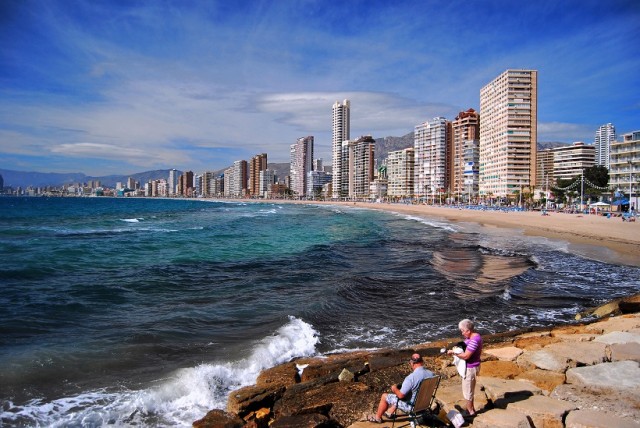Spain has turned much of its coastline into a playground for foreign tourists, in particular Britons buying second and retirement homes. That doesn’t mean the UK shouldn’t treat it seriously.
First published on Beacon.
Santo Domingo de la Calzada is a 900-year old town on the pilgrimage route across northern Spain to Santiago de Compestela, walked for centuries by travellers from all over Europe. Domingo Garcia helped pilgrims by building a causeway (calzada), roads, a church and a hostel. As a result, he is the patron saint of civil engineers, but is best known for the miraculous equivalent of a rhetorical flourish.
After reviving a boy who had been unjustly hanged, and faced with a disbelieving mayor, Domingo turned the politician’s roast dinner into two live chickens to demonstrate his resurrection skills. As a result of this he is now symbolised by not causeways or hostels, but by poultry. On his death in 1109, he was buried underneath the pilgrimage route, which now swerves to avoid the cathedral that has developed over centuries around his grave; it includes a gothic henhouse built into a wall, with a hen and a rooster pecking around. In the finest Catholic shrine tradition, a quietly tasteful range of souvenirs inspired by this event is available at the cathedral gift shop.

The point is that the town of Santo Domingo de la Calzada is thick with history, particularly the cathedral’s square. On its other sides are the cathedral’s tower, a separate building; another ancient church; and the original hostel for pilgrims.
Pilgrims still walk across this square, but most use a relatively new hostel a little way away. The old hostel, like several others on the pilgrimage route, was converted last century into a parador, one of a chain of hotels run by the Spanish government. Parts of the historical building remain, but most of it is modern, including its frontage on the cathedral square. (It’s the building to the right in the header image, with the church to the left.) Like the civil engineering of Santo Domingo, it is an example of Spain’s willingness to arrange and rearrange things for the benefit of travellers, even at the cost of its built and natural heritage.
It would take a fascist dictator for such mass reconstruction of old buildings to take place in Britain. That’s what it took in Spain: the paradores were founded in 1928 by Primo de Rivera, the founder of the fascist Falange party. (His name was been painted on, and later not entirely removed from, the cathedral’s wall on the square.) There are now more than 90 paradores across the country, some new but many housed in converted monasteries and pilgrim hostels, including the 500-year old one at the end of the trail in Santiago de Compostela – a town that has done pretty well out of its ‘discovery’ of the bones of St James (Iago in Spanish). There, conversion work in the 1950s left the spectacular main frontage largely unchanged. Instead, it added another storey of rooms to most of the rest of the building, and included a special entrance for de Rivera’s successor, Francisco Franco.
In Britain, historical buildings tend to be preserved as a kind of museum by organisations including the National Trust and English Heritage, rather than updated. The British way certainly beats letting them rot, but there’s a lot to be said for the parador solution. Hostels and monasteries have always been places of accommodation for travellers; why shouldn’t these buildings continue to perform the role for which they were built, even if at somewhat higher prices? Many paradores are brilliant hotels, a winning combination of luxury and strong historical character. And while a historical site can bring visitors and money to a town, they spend much more if they stay overnight.
We’re all off to sunny Spain
Paradores get 65% of their business from Spaniards, but Spain’s more recent tourism developments have been focused on overseas markets. The last few decades have seen a steep decline in British seaside resorts as Spain used the advent of cheap aviation to pioneer international mass tourism. Many British resorts had been set up in the 19th and early 20th centuries to offer cheap holidays for factory workers; by the 1960s they were old-fashioned and ripe for competition. Southern Spain had the advantages of near-guaranteed sunshine, the ability to start from scratch – and another fascist dictator keen on tourism.
Benidorm was Spain’s first mass resort, turning itself from a quiet fishing village into the fourth biggest collections of skyscrapers in Europe, the Spanish equivalent of Honolulu. As Giles Tremlett describes in his book Ghosts of Spain, Franco invited the town’s mayor to visit him whenever he had a problem developing tourism in Benidorm, something the mayor took advantage of on several occasions, including helping to clear the way for bikinis in what was then a conservatively Catholic country.
Benidorm continues to pack in tourists on package deals, and overall 16m of Spain’s 53m tourists each year come from the UK. But Spain has taken things further again with the development of much of its southern coastline, where foreigners have been encouraged to settle, and have done so in huge numbers. Mr Tremlett writes that the Costa del Sol can be seen as the 14th largest British city, with perhaps 300,000 resident Britons – no-one knows for sure, as there’s no requirement to register – and many more owning second homes.

These recent developments have caused problems, both to Spain and to its new residents. Benidorm’s high-rise hotels may not be to everyone’s taste architecturally but they make highly efficient use of land, whereas the more recent developments are famous for low-density sprawl. Quite a few of these were approved by local authorities through bribery or other murky means. This has seen Britons buying property unable to get connected to roads, power or water. The worst cases have seen people evicted, their properties then demolished without compensation.
This used to be our playground
Britain has seen Spain as something of a playground, as a result of all those holidays, as well as a reputation for lawlessness. Apart from Britons losing their homes and the ongoing arguments over Gibraltar (a British territory as a result of the 1713 Treaty of Utrecht, with a population that wants to stay under UK control; the Spanish don’t quite see it that way) the latter comes mainly from the fact that between 1978 and 1985, there were no extradition arrangements between Britain and Spain. This led to the ‘Costa del Crime’, where wanted criminals lived in Spain with apparent impunity. Brits on the run apparently prefer Thailand nowadays and the Spanish police are working hard on extraditions, but the ability to melt into what may well be the world’s biggest crowd of ex-pat Brits still makes it a place to run and hide.
It’s an outdated image. Spain has modernised fast since Franco’s death in 1975, and although Giles Tremlett makes a good case that it has preferred to bury its fascist past rather than deal with it – not least through all the tourism development – it is one of Britain’s stronger allies in Europe. Like Ireland, it got through austerity caused by the financial crash (although at huge cost in youth unemployment) and is now seen as less risky than the likes of Italy and Portugal – in fact, it is growing faster than Germany and France.
There are other similarities. Like Britain, it currently has a right-leaning government and a history of dealing terrorism, both territorial – the IRA in Northern Ireland, ETA in the Basque Country – and now Islamist, after the attack on Madrid’s trains in 2004. In the recent Grexit crisis, Spain was on the side of the north Europeans in opposing unconditional bail-outs. British Airways and Spanish flag-carrier Iberia are owned by the same company, IAG, following a 2010 merger. The biggest foreign consumer bank in Britain is Spain’s Santander, after its purchase of several stricken UK banks in the financial crisis.
The two countries also share well-founded fears of splitting up. Things have quietened down in the Basque Country as they have in Northern Ireland, and Galicia like Wales focuses largely on language and culture. But Catalonian politicians have threatened to hold an illegal referendum on independence, pointing to Scotland’s of last year. While politicians in the Castilian core of Spain probably wish the UK hadn’t granted that, they may have helped convince Scots to vote No by making it clear they would make it difficult for an independent Scotland to join the EU in the way it wanted.
Britain should see Spain as a serious European ally, but tends to view it as a place for holidays, second homes and retirement. That is partly because Spain is a beautiful, sunny place, and partly because Spain has spent decades encouraging northern Europeans to think of it as a place for pleasure rather than business. It is both.

